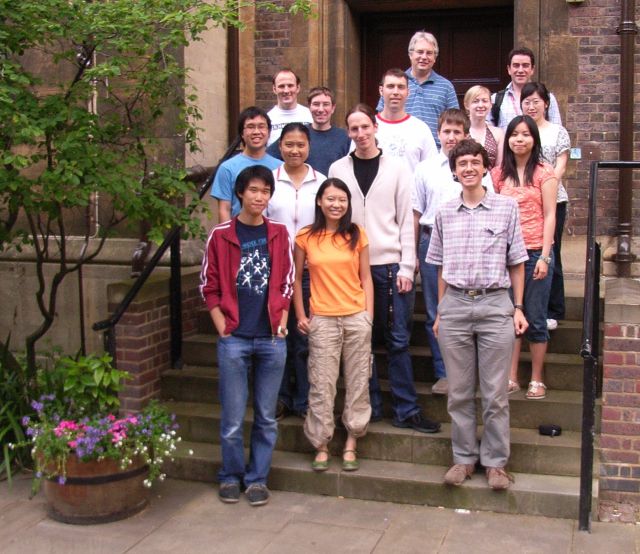Cambridge/Project summary
From 2007.igem.org
Jamesbrown (Talk | contribs) m |
m (Cambridge moved to Cambridge/Project summary) |
||
| (13 intermediate revisions not shown) | |||
| Line 1: | Line 1: | ||
| - | + | Jump to our [http://www.ccbi.cam.ac.uk/iGEM2007 team wiki (external)] | |
| - | + | == Introduction == | |
| - | + | ||
| - | + | This year's [http://www.ccbi.cam.ac.uk/iGEM2007 Cambridge iGEM team], made up of five physical scientists with a biological bent and six biologists who want to try something a bit different, has been working since the start of July to get to grips with Synthetic Biology, and then to push its frontiers. After extensive brainstorming, we have decided to work on three projects to add to the capabilities of the Registry. | |
| - | + | ||
| - | + | The first strand of our research is the construction of one or more well-characterised '''PoPS amplifiers''', based on a number of protein activators and cognate inducible promoters from a number of ''E. coli'' phages investigated by other researchers. At present we are integrating the six promoter sequences and three activator sequences into plasmids; we will then carry out double transformations to generate and characterise the 18 different combinations. [http://www.ccbi.cam.ac.uk/iGEM2007/index.php/Amplifier_project More details on our website...] | |
| - | + | ||
| - | + | In parallel, we are developing ''Bacillus subtilis'' as a '''Gram-positive chassis''' for conducting sythetic biology experiments. This involves identifying, obtaining and testing suitable strains, plasmids (especially shuttle vectors between ''B. subtilis'' and ''E. coli''), protocols and biobrick parts (promoters, RBSes, reporter proteins and terminators); at present we are testing growth and transformation protocols using different strains and vectors. Gram-positive bacteria have a number of advantages, particularly for protein secretion and chromosomal insertion of DNA. [http://www.ccbi.cam.ac.uk/iGEM2007/index.php/Bacillus_subtilis_SynBio_chassis More details on our website...] | |
| - | + | ||
| - | + | Finally, we are re-engineering the '''Agr (Accessory Gene Regulator) oligopeptide quorum sensing system''' from ''Staphylococcus aureus'' into a PoPS-compatible intercellular signalling system, with BioBricks for the signal senders and receivers. Initially, we will make use of the ''B. subtilis'' chassis to test our system (since ''S. aureus'' is also Gram-positive); we also plan to attempt to transfer the system to a Gram-negative chassis (''E. coli'') using a mutant pore protein to render the outer membrane permeable to oligopeptides and other small molecules. [http://www.ccbi.cam.ac.uk/iGEM2007/index.php/Signalling_project_description More details on our website...] | |
| - | + | ||
| - | + | == The team == | |
| - | + | ||
| - | + | [[Image:Cambridge Group photo.jpg|thumb|500px|center|The Cambridge iGEM 2007 team!]] | |
| - | + | ||
| - | + | Front row, from left: Narin Hengrung, Yi Han, David Wyatt | |
| - | + | ||
| - | + | Second row, from left: Zhizhen Zhao (Jane), Stefan Milde, Dmitry Malyshev, Xinxuan Soh (Sheila) | |
| - | + | ||
| - | + | Third row, from left: Yi Jin Liew, John Crowe, Lovelace Soirez, Stephanie May, Yue Miao | |
| + | |||
| + | Back row, from left: James Brown (PhD student mentor), Jim Haseloff (faculty), Gos Micklem (faculty) | ||
| + | |||
| + | Not in photo: Lorenz Wernisch, Tony Southall, Duncan Rowe | ||
Latest revision as of 22:13, 25 October 2007
Jump to our [http://www.ccbi.cam.ac.uk/iGEM2007 team wiki (external)]
Introduction
This year's [http://www.ccbi.cam.ac.uk/iGEM2007 Cambridge iGEM team], made up of five physical scientists with a biological bent and six biologists who want to try something a bit different, has been working since the start of July to get to grips with Synthetic Biology, and then to push its frontiers. After extensive brainstorming, we have decided to work on three projects to add to the capabilities of the Registry.
The first strand of our research is the construction of one or more well-characterised PoPS amplifiers, based on a number of protein activators and cognate inducible promoters from a number of E. coli phages investigated by other researchers. At present we are integrating the six promoter sequences and three activator sequences into plasmids; we will then carry out double transformations to generate and characterise the 18 different combinations. [http://www.ccbi.cam.ac.uk/iGEM2007/index.php/Amplifier_project More details on our website...]
In parallel, we are developing Bacillus subtilis as a Gram-positive chassis for conducting sythetic biology experiments. This involves identifying, obtaining and testing suitable strains, plasmids (especially shuttle vectors between B. subtilis and E. coli), protocols and biobrick parts (promoters, RBSes, reporter proteins and terminators); at present we are testing growth and transformation protocols using different strains and vectors. Gram-positive bacteria have a number of advantages, particularly for protein secretion and chromosomal insertion of DNA. [http://www.ccbi.cam.ac.uk/iGEM2007/index.php/Bacillus_subtilis_SynBio_chassis More details on our website...]
Finally, we are re-engineering the Agr (Accessory Gene Regulator) oligopeptide quorum sensing system from Staphylococcus aureus into a PoPS-compatible intercellular signalling system, with BioBricks for the signal senders and receivers. Initially, we will make use of the B. subtilis chassis to test our system (since S. aureus is also Gram-positive); we also plan to attempt to transfer the system to a Gram-negative chassis (E. coli) using a mutant pore protein to render the outer membrane permeable to oligopeptides and other small molecules. [http://www.ccbi.cam.ac.uk/iGEM2007/index.php/Signalling_project_description More details on our website...]
The team
Front row, from left: Narin Hengrung, Yi Han, David Wyatt
Second row, from left: Zhizhen Zhao (Jane), Stefan Milde, Dmitry Malyshev, Xinxuan Soh (Sheila)
Third row, from left: Yi Jin Liew, John Crowe, Lovelace Soirez, Stephanie May, Yue Miao
Back row, from left: James Brown (PhD student mentor), Jim Haseloff (faculty), Gos Micklem (faculty)
Not in photo: Lorenz Wernisch, Tony Southall, Duncan Rowe
